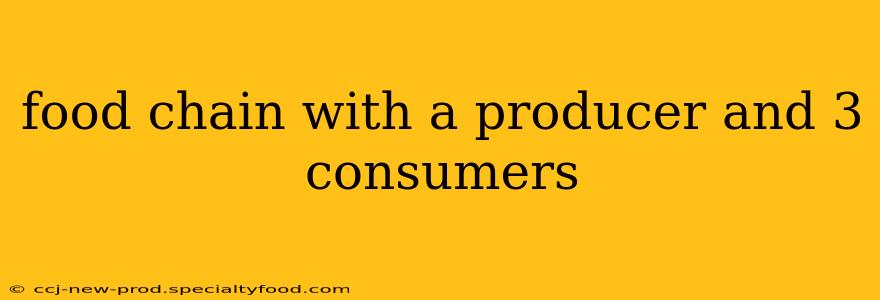A food chain illustrates the flow of energy in an ecosystem. It shows how organisms obtain energy by eating other organisms. At the base of every food chain is a producer, an organism that creates its own food, typically through photosynthesis. Above the producer are various levels of consumers, organisms that obtain energy by consuming other organisms. This article will explore a food chain with a producer and three consumers, examining the relationships and energy transfer within this simplified ecosystem.
What is a Producer in a Food Chain?
A producer, also known as an autotroph, forms the foundation of any food chain. The most common producers are plants, algae, and some bacteria. These organisms use sunlight, water, and carbon dioxide to produce their own food through photosynthesis. This process converts light energy into chemical energy stored in sugars, providing the energy base for the entire food chain. Without producers, there would be no energy to support the rest of the ecosystem.
What are Consumers in a Food Chain?
Consumers, or heterotrophs, are organisms that cannot produce their own food and must obtain energy by consuming other organisms. There are various types of consumers, depending on their position in the food chain:
-
Primary Consumers (Herbivores): These consumers eat producers. Examples include rabbits, deer, grasshoppers, and many types of insects.
-
Secondary Consumers (Carnivores/Omnivores): These consumers eat primary consumers. Examples include foxes, snakes, and some birds.
-
Tertiary Consumers (Apex Predators): These consumers are at the top of the food chain and typically eat secondary consumers. They often have few or no natural predators. Examples include lions, wolves, and sharks.
Example of a Food Chain with a Producer and Three Consumers
Let's consider a simple terrestrial food chain:
- Producer: Grass
- Primary Consumer: Grasshopper (eats the grass)
- Secondary Consumer: Frog (eats the grasshopper)
- Tertiary Consumer: Snake (eats the frog)
In this example, the energy flows from the grass (producer) to the grasshopper (primary consumer), then to the frog (secondary consumer), and finally to the snake (tertiary consumer). Each consumer obtains energy by consuming the organism below it in the chain. It's important to note that the energy transfer is not perfectly efficient; a significant portion of energy is lost at each level as heat.
What are some examples of food chains with 3 consumers?
This question can be answered with a variety of examples, depending on the ecosystem you consider. Many food chains can be constructed to include three consumer levels, and the specific organisms will depend on the habitat. Here are a few examples:
- Marine Ecosystem: Phytoplankton (producer) → Krill (primary consumer) → Herring (secondary consumer) → Tuna (tertiary consumer)
- Forest Ecosystem: Tree (producer) → Deer (primary consumer) → Wolf (secondary consumer) → Bear (tertiary consumer)
- Grassland Ecosystem: Grass (producer) → Rabbit (primary consumer) → Fox (secondary consumer) → Eagle (tertiary consumer)
How does energy flow through a food chain with a producer and three consumers?
Energy flows in a unidirectional manner through the food chain. The producers capture energy from sunlight through photosynthesis and convert it into chemical energy stored in organic matter. Primary consumers derive energy by consuming producers, secondary consumers feed on primary consumers, and tertiary consumers feed on secondary consumers. At each trophic level (feeding level), a significant portion of energy is lost as heat due to metabolic processes and is not available to the next trophic level. This energy loss explains why there are usually fewer organisms at higher trophic levels in a food chain.
What happens if one level of the food chain is removed?
Removing any level of a food chain can have significant and cascading effects throughout the ecosystem. For instance, if the primary consumer is removed, the secondary consumer will lose its food source, potentially leading to a decline in its population or even extinction. This would also affect the tertiary consumer, which would lose its food source as well. The removal of a producer would have the most catastrophic effect, causing the collapse of the entire food chain.
This simplified model demonstrates the fundamental principles of a food chain. In reality, ecosystems are much more complex, with multiple interconnected food chains forming a food web. However, understanding the basic structure of a food chain with a producer and three consumers provides a crucial foundation for grasping the complexities of energy flow and ecological interactions.
